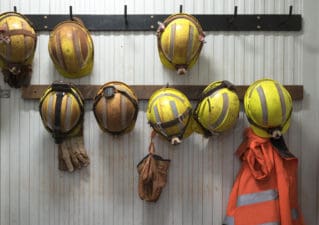The past few years have been hard for resource investors.
Following big declines in commodity prices, Canadian mining companies have been forced to write-off tens of billions in failed projects. And the broad-based iShares S&P/TSX Capped Materials Index (TSX:XMA), a good proxy of the nation’s mining industry, is off 35% over the past two years. Whether you’re talking uranium, natural gas, or potash, most investors would prefer to just avoid discussing the sector in its entirety.
But commodity investing expert Rick Rule is optimistic on the resource industry and sees a number of catalysts that could lift prices in the near future. Below is the transcript of our conversation; it has been lightly edited for clarity.
Robert Baillieul: We’re down 50% or more on a lot of these key mining indices. Yet you have maintained your bullish stance on commodities. Why are you sticking to your guns and going against the crowd in this case?
Rick Rule: Well precisely because to exist in the commodities market you have to go against the crowd. The truth is that these are capital intensive, cyclical businesses. When they feel like they’re at their best, they’re setting you up for a fall. And when they feel like they’re at their worse, they’re at their absolute cheapest.
In commodity markets, to make money in a sure fashion you find a commodity for which their is certain, on-going demand, where the cost structure of the industry exceeds the sale price of the product and where the industry is losing money on every unit of the product they produce. That sounds counterintuitive. But the truth is that in that situation either the commodity price rises or their is no availability of that commodity again.
Some of your readers may remember the incredible cycle we had in the uranium market 15 years ago that is wonderful for illustrative purposes. In 2000, uranium cost the industry $20 per pound to market but it sold for $10 per pound. The miners, in their wisdom, lost $10 per pound and tried to make it up on volume.
But the truth was that while things seemed their bleakest, it was pretty certain to anyone bothered to watched that the price of uranium had to go up or the lights would go out. That was the choice. The industry couldn’t continue to operate losing 50% on every sale that they made. And the world, despite the fact that there were strong anti-nuclear factions that existed then as they do now, couldn’t continue to run the grid without nuclear power. The point of it is that when the outlook looked the worst, the values in the sector were the best because the seeds were already set for a recovery.
With regards to broader commodity markets, what we’ve seen is a situation where the narrative associated with commodity pricing hasn’t changed.
The narrative is in the first instance in terms of nominal pricing. Western fiat currencies are under pressure as a consequence of the fact that the promises we made to each other – things like social security, medicaid, and medicare – exceed our ability to pay.
In the strongest of the Western economies, the United States, we have an almost $18 trillion on-balance sheet obligations. And according to the Congressional Budget Office, a $70 trillion off-balance sheet obligation. And we’re a strong economy.
That figure gets worse every year because as a society, at the Federal level not the state and local level, we spend a trillion dollars more than we take in. We are able to borrow about $750 billion of that deficit from each other and foreigners. That leaves us about $250 billion in unfunded current liabilities which are met by quantitative easing in other words we print money to buy the obligation from ourselves. Quantitative easing is better characterized as counterfeiting.
As the realization that exists in the market that the fiat currencies are burdened by liabilities that society can’t ultimately meet, there’re two ways out of that situation.
First is an honest default where we say to entitlement beneficiaries and other government beneficiaries, ‘Yes, we promised you all of this stuff but we lied and we can’t make it work.’ The defaults in Cypress are a classic example of that.
Or you can default dishonestly by inflating away the net present value of the purchasing obligation of the center. That’s the nominal pricing argument for commodities. It’s the basic argument that led to the mini-gold bull market of 2009 to 2010. And I would suggest to you that that narrative is still very much in tact today.
The other narrative associated with resources is the fact that there are seven billion people on earth, a number that is rising fairly rapidly, and all of those people want to live like you and I live. And to do that requires increasing calories and increasing amounts of physical commodities.
The second part of that narrative is that people in frontier and emerging markets become gradually more free they become rapidly more rich. The supporting part of that narrative was a quote from Deng Xiaoping who said to be rich is glorious. And that change in thesis in China led to a GDP per capita from $500 to $5,000 in 30 years.
Again this was the narrative, increasing per capita consumption spread over billions of per capita that drove the resource market over the last decade. I believe that that narrative is still completely unchanged. What has been changed is that the momentum came out of the narrative. And as a consequence that price expectations associated with the narrative has changed. The fact from my point of view is that the narrative is still unchanged.
Baillieul: I might have agreed with that whole thesis maybe three or four years years ago. My issue now is that I look at all of the QE that the Fed has done and yet I don’t see inflation. Why haven’t we seen higher prices yet?
Rule: Well, I think there’re two parts to that question. So let me try to answer them sequentially. With regards to inflation first of all, the stated rate of inflation is the CPI, the consumer price index, which is alleged to be a cost of living index. And that is alleged to be at 2.1% or 2.2%.
To that I can say whoever compiles the index shops somewhere that I don’t shop. The idea that my cost of living is only increasing by 2.1% or 2.2% is silly. The second part of that is that when convenient the index doesn’t include food or fuel. I object to those exclusions. I drive and I eat.
Certainly the people over at ShadowStats, and I can’t independently confirm this, would say that if inflation were categorized in the same fashion that it was in the early 1980’s that the CPI stated rate of inflation would be substantially higher than the 2.1% or 2.2%. Certainly the prices for goods and services in the places that I shop, Costco and supermarkets, the 2.1% or the 2.2% number that is thrown out is absurd. I think again this is a models driven number.
But a bigger objection that I have to the CPI and to the thesis that you’ve talked about, is the fact that the CPI doesn’t include taxes. Now if I didn’t have to pay the tax, I certainly wouldn’t complain about the index. But the truth is, that tax is an important part of my cost of living.
One of the reasons that the on-balance sheet deficit of the Federal government has increased is the fact that highly productive citizens like myself have seen their real cost of living go up substantially in the past 18 months. And the fact that the cost associated with government isn’t factored in as a component of my cost of living means the index is at best fiction. I can’t say it more clearly than that.
In terms of the fact that there has been a weakening in terms of commodity prices is evidence of a pretty simple fact that markets work. Demand for commodities began to be constrained in the second half of the last decade firstly because of higher real commodity prices.
When the iron ore price advances 600%, demand for iron ore begins to falter. Its utility begins to decline at the same time that supply increases. So using iron as an example, you double the capacity of Tobarra (the largest iron field in the world), you increase the productive capacity the iron fields of Brazil by 50%, and you bring on more supplied from West Africa. At the same time you greatly increase the cost to users.
The second thing that has happened to depress commodity prices, and this part of the discussion I sympathize with your thesis, is that slower demand from western economies began to offset fairly strong demand from emerging markets. And while people look to places like China and India as the future of these markets, they neglect the fact that the good ol’ United States is still the world’s mouth.
Now in commodities markets is these commodities producers are adjusting themselves to a lower level of sustain demand for industrial commodities in Western nations. They’re right-sizing themselves by slowing down the pace of capital expenditures and setting themselves up for the ability to increase prices as emerging market demand continues stronger. We have adjusted, if you will, to the reality that incremental demand will come from economies like Indonesia, and Chile, and Pakistan, and the BRIC’s [Brazil, Russia, India, and China].
Coming up next…
The commodity bull market may still be intact, but how do investors actually take advantage of this opportunity. In part three of my conversation with Rick, we discuss the state of the mining industry and where investors should be putting their capital.







